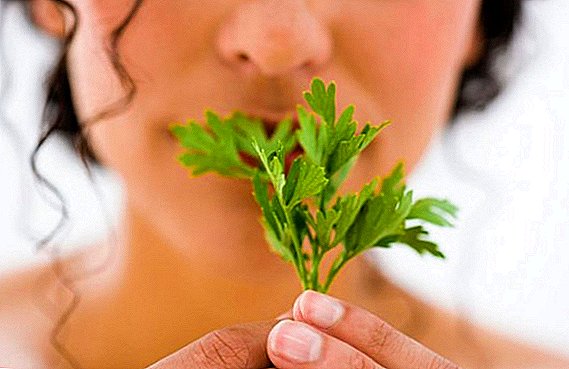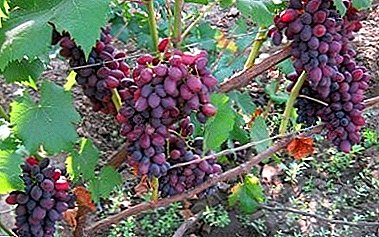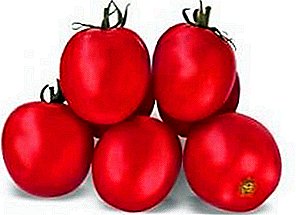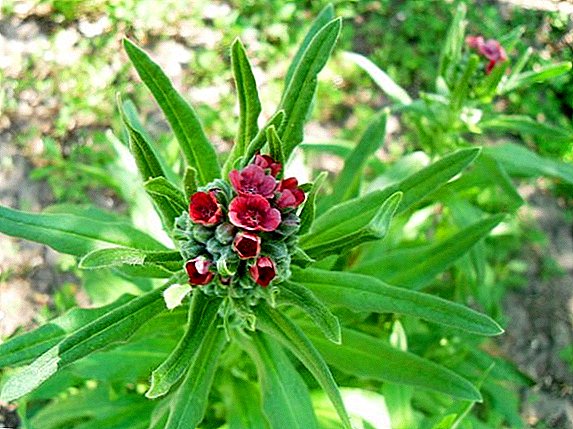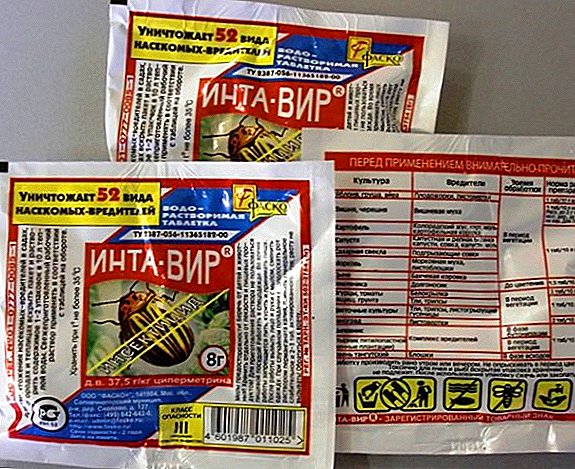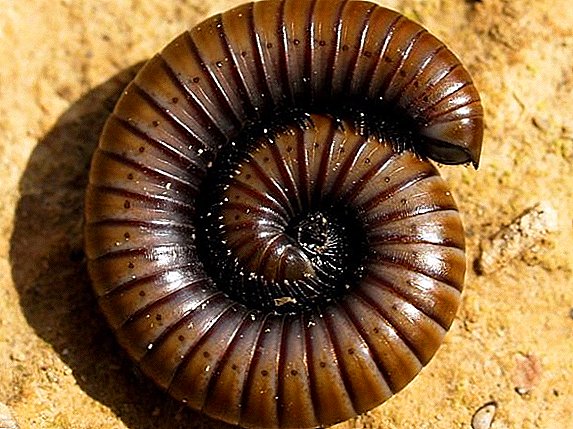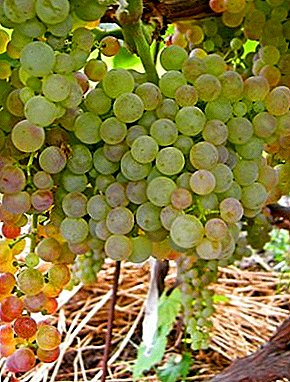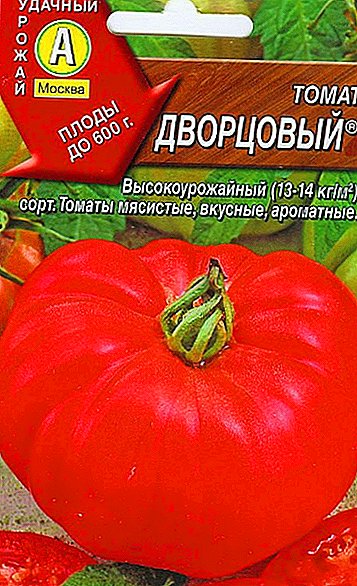 Most suitable for growing in temperate latitudes tomato variety "Palace". This is the fruit of the works of Sh. G. Bekseev, but not everyone can grow it. Let's find out in the article how to do this to get a decent harvest.
Most suitable for growing in temperate latitudes tomato variety "Palace". This is the fruit of the works of Sh. G. Bekseev, but not everyone can grow it. Let's find out in the article how to do this to get a decent harvest.
Variety description
Tomato of this variety grows up to 1.2 m in height. Spread bush with powerful stems. It is one-year-old and has a simple inflorescence: the first one starts to be laid above 8 leaves, and each next - after 2 leaves. The fruit of the plant is red, flattened, rounded and ribbed.
The main advantages of the "Palace":
- early maturity;
- low seed;
- long period of fruiting;
- fruits large and sugary in taste (up to 600 g).
Among the shortcomings it is worth highlighting the need for regular dressings, without which the harvest will be excessively poor. 
Get acquainted with the nuances of growing such varieties of early ripe tomatoes like "Samara", "Raspberry giant", "Tolstoy f1", "Blagovest", "Bokele F1", "Kiss of geranium", "Ladies fingers", "Caspar", "Aelita Sanka" "," Gulliver F1 "," Batyana "," Snowdrop "," Miracle of the Earth "," Irina f1 "," Countryman "," Little Red Riding Hood ".
Fruit characteristics and yield
With proper farming techniques, up to 4 kg of large fleshy fruits can be harvested from the bush. This tomato has an early ripening period - up to 100 days. The average weight of the fruit - 500 g. It is recommended to use for the preparation of fresh salads, ketchups, sauces, pastes and juice.
Did you know? The tomato contains a large amount of serotonin, so it raises the mood just like a chocolate bar.
Video: description of the fruits of the tomato "Palace"
Selection of seedlings
Choosing seedlings, it is worth paying attention to every detail:
- An age that should not exceed the 60-day mark. In addition, the age of seedlings located on the same bed should be the same, so that the fruiting is uniform.
- Height. This parameter should be less than 30 cm. The recommended number of leaves on a plant is 12 pcs.
- Stems and leaves. The stem should be thick, and the leaves - rich green. Twisted bright green leaves say that the seller used a lot of nitrogen fertilizer to accelerate growth. Such copies are also not worth buying.
- The presence of signs of infection by diseases or pests: under the leaves of the eggs of parasites, they themselves are wrinkled or deformed, spots on the stems, etc.
- Tara, in which she is. These should be boxes with earth, not plastic bags.

Soil and fertilizer
In the seedling method, seeds are sown in advance in special boxes with prepared soil mixture: sod land (2/5), humus (2/5), sand (1/5). If planting is done directly in open ground, you must first fertilize it with organic matter.
It will be useful for you to read what types of soil exist, how to improve soil fertility, how to independently determine the acidity of the soil at the site, as well as how to deoxidize the soil.
For landing suitable southern parts of the land. The soil should be fertile, light with a neutral or slightly acid reaction. It is better if before that cucumbers, cabbage, onions, potatoes, carrots, pumpkins or squash were grown there.
It is not recommended to plant tomatoes in the same place for several years in a row, as well as in the place where peppers, eggplants and physalis were previously grown. If it is not possible to find another plot, it is necessary to plant organic fertilizers into the soil before planting the tomatoes. 
Important! Immediately before planting, the hole is filled with ash, so that the tomato is enriched with all the trace elements it needs.
Growing conditions
"Palace" - heat and light-loving plant. The recommended temperature for disembarkation is above + 12 ° C. The soil should be well heated. For tomato germination, it is necessary to maintain the temperature at + 16 ° C, after the first shoots appear, normal growth will be + 18-20 ° C.
To ensure a normal light balance, it is recommended to use artificial lighting (several incandescent lambs placed along the perimeter). The plant also needs fresh air, so the room in which it lives must be regularly ventilated.
Regarding the level of humidity - the tomato is better to plant in a well-moistened soil. It should be planted in the evening or rainy day. Relative humidity should be about 50%, soil - 70%. 
Growing from seed to seedlings at home
Growing seedlings at home is not as easy as purchasing it, but anything is possible. In addition, you will be sure of its quality.
Seed preparation
Seed material must be processed before planting:
- Disinfect with 1% potassium permanganate solution. They are placed in this liquid for about 30 minutes to prevent the appearance of viruses.
- Harden the seeds by heating at + 55 ° C for 72 hours. After that, they should be soaked in water, the temperature of which is + 25 ° C, for a day. The final stage is cooling at a temperature of -2 ° C (in the refrigerator).
- Treatment with a solution of boric acid to accelerate growth and increase yield. 2 mg of the solution is diluted with a liter of water and the seeds are placed there. After 24 hours, they are removed and dried to a crumbly state.
Video: preparation of tomato seeds for planting
Content and location
Tomato seeds are planted in special boxes with soil. At this point, the air temperature should not be below + 16 ° C. Drawers recommended to place on the shelves under the heating lamps. After 14 days, small sprouts that appear have been transplanted into peat pots.
Did you know? Since 2001, tomato, as in the Old World earlier, is considered a fruit by order of the European Union.
Seed planting process
Before planting, preparation requires not only seeds, but also soil. A mixture of turf land, humus and sand is made. The material is laid in the soil no deeper than 2 cm. The time for sowing is chosen by the gardener, taking into account that after 50-60 days the seedlings should be transplanted into the open ground.  After planting, the future seedlings are watered. Fertilize it for the first time after disembarkation after 7 days.
After planting, the future seedlings are watered. Fertilize it for the first time after disembarkation after 7 days.
Seedling care
In order for the seeds to quickly reset the shell, it is necessary to conduct a series of irrigations with warm water. A dive is performed when the plant acquires 2 true leaves (approximately on the 20th day). Watering is done at the root as needed.
Water entering the leaves can cause the plant to rot. Tomatoes do not like abundant watering. 2 weeks before transplanting seedlings into open ground, it is hardened, reducing watering. Plants are treated with Bordeaux liquid, fed with potassium and taken out in the sun for several hours a day.
For example, for better root development, seedlings are treated with a special solution from water (1 l), ammonium nitrate (1 g), superphosphate (4 g) and sulphate (7 g). A permanent place is also being prepared for transplantation: in a week it is fertilized with organic matter - 10 kg / sq. m 
Transplanting seedlings to ground
As a rule, tomato seedlings are placed in open soil in June (middle of the month). Each plant is sunk into the ground to the cotyledon leaves - by 4-5 cm. The well is filled with ashes or half a teaspoon of Urgasa is added.
Immediately after planting, watering and mulching are carried out. The optimal distance between rows is 30-50 cm, between plantings - 30 cm.
Important! On 1 square. m can not be placed more than 4 shoots.
Video: planting tomato seedlings in the ground
Agricultural technology of growing tomato seeds in the open ground
Tomatoes can be grown not only by seedlings, but also directly in open ground.
Outdoor conditions
It is possible to sow seeds only when the soil is already warm enough (at least + 12 ° C) and the threat of frost has passed. The most suitable, protected from temperature changes and pests in this case - the greenhouse, greenhouse. They dig up the earth beforehand, fertilize it with organic matter and moisturize it.
Seeds undergo the same preparation as in the seedling method. In the greenhouse, they maintain the temperature regime (+ 20-25 ° C) and conduct regular airing. 
The process of planting seeds in the ground
Planting is done in April, when the climate stabilizes and the soil warms up. After preparation, the seeds are laid in the wells with a depth of no more than 4 cm, filled with ashes or fertilizers. The first feeding is carried out 10 days after planting, as well as watering.
As soon as the plants have 2-3 leaves, it is necessary to thin the crops, leaving a distance of 10 cm between them. The second time, the same manipulation is carried out when they have 5 leaves each to increase the distance between plants up to 15 cm.
Watering
Before flowering, watering is done every 3 days with warm water (above + 20 ° C). Water the plants at the root and only in the morning. The optimal amount of water per 1 square. m plantings - 10 l.  During the fruiting period, watering increases, since the root is already formed, and all the forces of the plant go to the formation of fruits. Under drought conditions, watering is more frequent and less frequent during the rainy season. It must be remembered that excess moisture can harm tomatoes.
During the fruiting period, watering increases, since the root is already formed, and all the forces of the plant go to the formation of fruits. Under drought conditions, watering is more frequent and less frequent during the rainy season. It must be remembered that excess moisture can harm tomatoes.
Soil loosening and weeding
In autumn, the next tomato bed is dug up, and in the spring - twice loosened. Weeding is mandatory carried out before planting, in order to get rid of weeds, then - as needed. In drought, in addition to increasing irrigation, it is also recommended to loosen the aisle in order to increase the capacity of the soil. The first hilling from the moment of landing is carried out on the 45-65 day, repeated - in 15 days.
Masking
As soon as the plant reaches the top of the trellis, its growth point is pinched, it forms a shrub in 1 stem, the lateral stepchildren are removed.
We recommend to read about how to properly pinch tomatoes in the open field and greenhouse.
Video: tomato pasynkovka For the first time pasynkovaniya spend when stepchildren (side shoots) reach 7 cm in length. Then they can be placed in water and after 20 days get a new bush. For seedlings fit stepchildren, obtained after 1-4 pasynkovany.
Garter
When the plant reaches 30-35 cm in height, it begins to tie.
We advise you to read about how and why to tie up tomatoes in open ground and in a polycarbonate greenhouse.
There are several methods of garter:
- To stakes (rods, etc.), the length of which exceeds the average height of the bushes by 30 cm to deepen them into the ground. They are set before planting. As the tomato grows, it is tied to a peg with a tape or other improvised means.
- To horizontal trellis. High stakes are driven into the ground at a distance of 2 m from each other. Further between them pull a wire (it is possible a string) with an interval of 40 cm between levels. The plant is tied up snakelike, huge brushes are hung on hooks.
- To vertical trellis. The plant is tied up to the greenhouse ceiling and, over time, as it grows, it "tightens" up.
- To the fence. The design is created with the help of a grid, which is tensioned from post to post along the plantations. Tie a tomato with twine at different levels of its growth.
- To the wire frame. The design resembles a rectangular box, inside which grows a bush. It does not need to tie up, as the design surrounds it round.

Top dressing
During the year, conduct several dressings:
- Before planting, in the fall, make 10 kg / sq. m organic, 20 g / sq. m of phosphate and 20 g / sq. m potash fertilizers.
- In spring, the soil is fertilized with a nitrogen mixture at the rate of 10 g / sq. m
- After planting on day 10, they conduct a liquid feeding: 25 g of nitrogen, 40 g of phosphate, 15 g of potash fertilizer per 10 liters of water. This amount is enough for 14-15 bushes.
- After 20 days, fertilizing is repeated by the same means. At this time, 10 liters is enough for only 7 plants.
- Dry dressing lay in the aisle. For this mixture is prepared from 5 g / sq. m of nitrogen, 10 g / sq. m of phosphate and 10 g / sq. m potash fertilizers.
- You can also feed the tomatoes with liquid organic.

Pests, diseases and prevention
Diseases that may affect the "Palace":
- late blight;
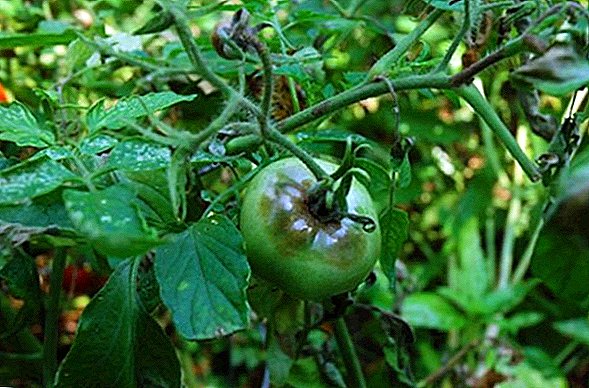
Familiarize yourself with the methods of controlling various diseases and pests of tomatoes.
- septoriosis;

- rot;
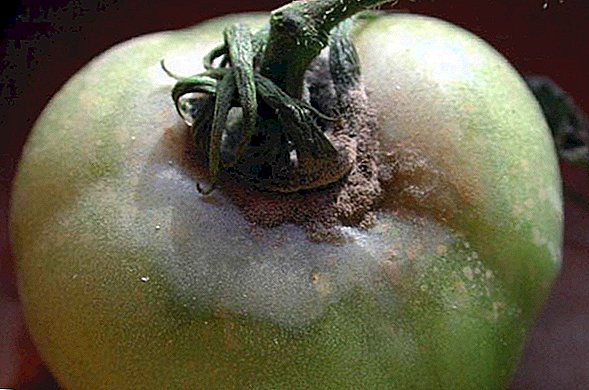
- macroporiosis and etc.

Of the pests should fear wireworm, Medvedka, whitefly, nematodes and moths. Therefore, after the appearance of the ovary (the size of a nut), the bush is sprayed with "Tomato Saver", Bordeaux mixture or copper sulfate. Treatments can be alternated every week. Total spend no more than 4 treatments per season - this is quite enough to protect the plant.
Learn more about the consequences of poisoning the human body with copper sulphate.
Harvesting and storage
Tomatoes are harvested as they ripen, carefully cutting from the bush. 20 days before the final harvesting, the buds are removed so that the fruits ripen faster. For longer storage tomatoes are cut even brown. The optimal storage temperature is + 15-20 ° C. 
Possible problems and recommendations
The main problems arising from improper care, and their causes:
- Hollow fruit, twisted leaves with a dry border - lack of potassium.
- Slow growth, foliage abscission - nitrogen deficiency.
- The underside of the leaves has a purple hue; growth slows down (absorption of nitrogen is blocked) - lack of phosphorus.
- "Marble" leaves - a lack of magnesium.
- Falling ovaries - a surplus of nitrogen.
Tomato "Palace", despite all the advantages of the variety, is not easy to grow. In order to get a large harvest, you need to properly care for the plant: regularly feed, water, loosen the soil, carry out processing and so on. It is because of the neglect of the rules that gardeners often have complaints about the “Palace”.






